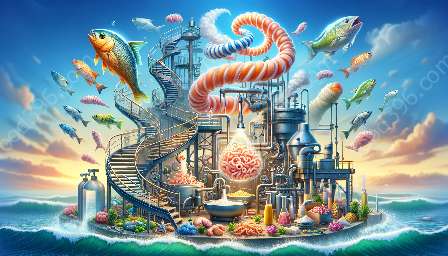As the demand for seafood continues to rise, so does the amount of fish waste and by-products. This has prompted the need for innovative solutions to utilize and manage fish waste more effectively. In this topic cluster, we will explore the practical and sustainable methods of fish waste utilization, seafood by-product utilization, and waste management, while delving into the science behind seafood waste and its implications on the environment and economy.
Understanding Fish Waste and By-Products
Fish waste refers to the parts of the fish that are often discarded after processing, including heads, bones, scales, fins, and viscera. On the other hand, seafood by-products encompass a broader range of materials, such as shells, skins, and trimmings, which are generated during the processing of fish and shellfish.
These by-products have traditionally been considered as waste, leading to environmental concerns and economic inefficiencies. However, there is growing recognition of the potential value in these materials, driving the development of innovative utilization methods.
Utilization of Fish Waste
Several industries have recognized the untapped potential of fish waste and have been exploring various methods to utilize it effectively. One of the most significant applications is the extraction of fish oil and fishmeal. Fish oil is rich in omega-3 fatty acids and is utilized in pharmaceuticals, dietary supplements, and even as an ingredient in aquaculture feeds. Similarly, fishmeal is an important protein source for animal feeds, particularly in aquaculture and livestock industries.
Beyond fish oil and fishmeal, fish waste can also be used in the production of biodiesel, fertilizers, and even functional food ingredients. By extracting valuable compounds from fish waste, not only can environmental impacts be mitigated, but new revenue streams can be created.
Seafood By-Product Utilization
The utilization of seafood by-products extends beyond fish waste and encompasses a wide range of applications. For instance, chitin, a polysaccharide found in the shells of crustaceans, has been utilized to produce chitosan, a versatile biopolymer with applications in various industries, including pharmaceuticals, agriculture, and food packaging.
In addition, collagen, a protein found in fish skin and scales, has been harnessed for its potential use in cosmetics, pharmaceuticals, and biomedical applications. These examples highlight the diverse opportunities for adding value to seafood by-products and reducing waste in the industry.
Waste Management Strategies
Efficient waste management is crucial for minimizing the environmental impact of seafood processing. One approach involves the development of integrated waste management systems that focus on reducing, reusing, and recycling seafood processing waste. This includes measures such as composting, anaerobic digestion, and biorefinery processes to convert waste into biogas, organic fertilizers, and bio-based chemicals.
Furthermore, innovative technologies, such as enzymatic hydrolysis and extraction methods, are being explored to recover valuable compounds from seafood processing waste, contributing to a more sustainable and circular economy within the industry. By implementing these waste management strategies, the environmental footprint of seafood processing can be significantly reduced.
Seafood Science and Waste Impact
The science of seafood waste extends beyond its utilization and management to understand its impact on the environment and economy. Improper disposal of fish waste can lead to pollution, odors, and the depletion of oxygen levels in water bodies, affecting aquatic ecosystems. Moreover, the economic burden associated with inefficient waste management practices underscores the need for sustainable solutions.
By integrating principles of seafood science, including biochemistry, microbiology, and environmental science, the industry can develop more effective waste utilization and management strategies. This interdisciplinary approach is crucial for addressing the complex challenges posed by seafood waste and ensuring a more sustainable and responsible seafood industry.
Conclusion
The utilization of fish waste, seafood by-products, and the effective management of seafood processing waste are pivotal aspects of the seafood industry. By harnessing innovative technologies and scientific knowledge, the industry can transform what was once considered waste into valuable resources, while mitigating environmental impact and driving sustainable growth. Embracing these practices not only enhances the efficiency and profitability of seafood production but also contributes to the preservation of marine ecosystems and the well-being of communities that depend on them.

